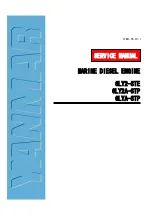
7.5
Flushing instructions
Flushing instructions in this Product Guide are for guidance only. For contracted projects,
read the specific instructions included in the installation planning instructions (IPI).
7.5.1
Piping and equipment built on the engine
Flushing of the piping and equipment built on the engine is not required and flushing oil shall
not be pumped through the engine oil system (which is flushed and clean from the factory).
It is however acceptable to circulate the flushing oil via the engine sump if this is advantageous.
Cleanliness of the oil sump shall be verified after completed flushing.
7.5.2
External oil system
Refer to the system diagram(s) in section External lubricating oil system for location/description
of the components mentioned below.
If the engine is equipped with a wet oil sump the external oil tanks, new oil tank (2T03),
renovating oil tank (2T04) and renovated oil tank (2T05) shall be verified to be clean before
bunkering oil. Especially pipes leading from the separator unit (2N01) directly to the engine
shall be ensured to be clean for instance by disconnecting from engine and blowing with
compressed air.
If the engine is equipped with a dry oil sump the external oil tanks, new oil tank and the system
oil tank (2T01) shall be verified to be clean before bunkering oil.
Operate the separator unit continuously during the flushing (not less than 24 hours). Leave
the separator running also after the flushing procedure, this to ensure that any remaining
contaminants are removed.
If an electric motor driven stand-by pump (2P04) is installed then piping shall be flushed running
the pump circulating engine oil through a temporary external oil filter (recommended mesh 34
microns) into the engine oil sump through a hose and a crankcase door. The pump shall be
protected by a suction strainer (2F06).
Whenever possible the separator unit shall be in operation during the flushing to remove dirt.
The separator unit is to be left running also after the flushing procedure, this to ensure that
any remaining contaminants are removed.
7.5.3
Type of flushing oil
7.5.3.1
Viscosity
In order for the flushing oil to be able to remove dirt and transport it with the flow, ideal viscosity
is 10...50 cSt. The correct viscosity can be achieved by heating engine oil to about 65°C or
by using a separate flushing oil which has an ideal viscosity in ambient temperature.
7.5.3.2
Flushing with engine oil
The ideal is to use engine oil for flushing. This requires however that the separator unit is in
operation to heat the oil. Engine oil used for flushing can be reused as engine oil provided that
no debris or other contamination is present in the oil at the end of flushing.
7.5.3.3
Flushing with low viscosity flushing oil
If no separator heating is available during the flushing procedure it is possible to use a low
viscosity flushing oil instead of engine oil. In such a case the low viscosity flushing oil must
be disposed of after completed flushing. Great care must be taken to drain all flushing oil from
pockets and bottom of tanks so that flushing oil remaining in the system will not compromise
the viscosity of the actual engine oil.
Wärtsilä 32 Product Guide - a21 - 7 September 2016
7-17
7. Lubricating Oil System
Wärtsilä 32 Product Guide
Summary of Contents for WARTSILA32
Page 18: ...This page intentionally left blank...
Page 72: ...This page intentionally left blank...
Page 130: ...This page intentionally left blank...
Page 150: ...This page intentionally left blank...
Page 186: ...This page intentionally left blank...
Page 204: ...This page intentionally left blank...
Page 210: ...This page intentionally left blank...
Page 216: ...This page intentionally left blank...
Page 238: ...This page intentionally left blank...
Page 246: ...This page intentionally left blank...
Page 248: ...This page intentionally left blank...
Page 251: ......
Page 252: ......
Page 253: ......
















































